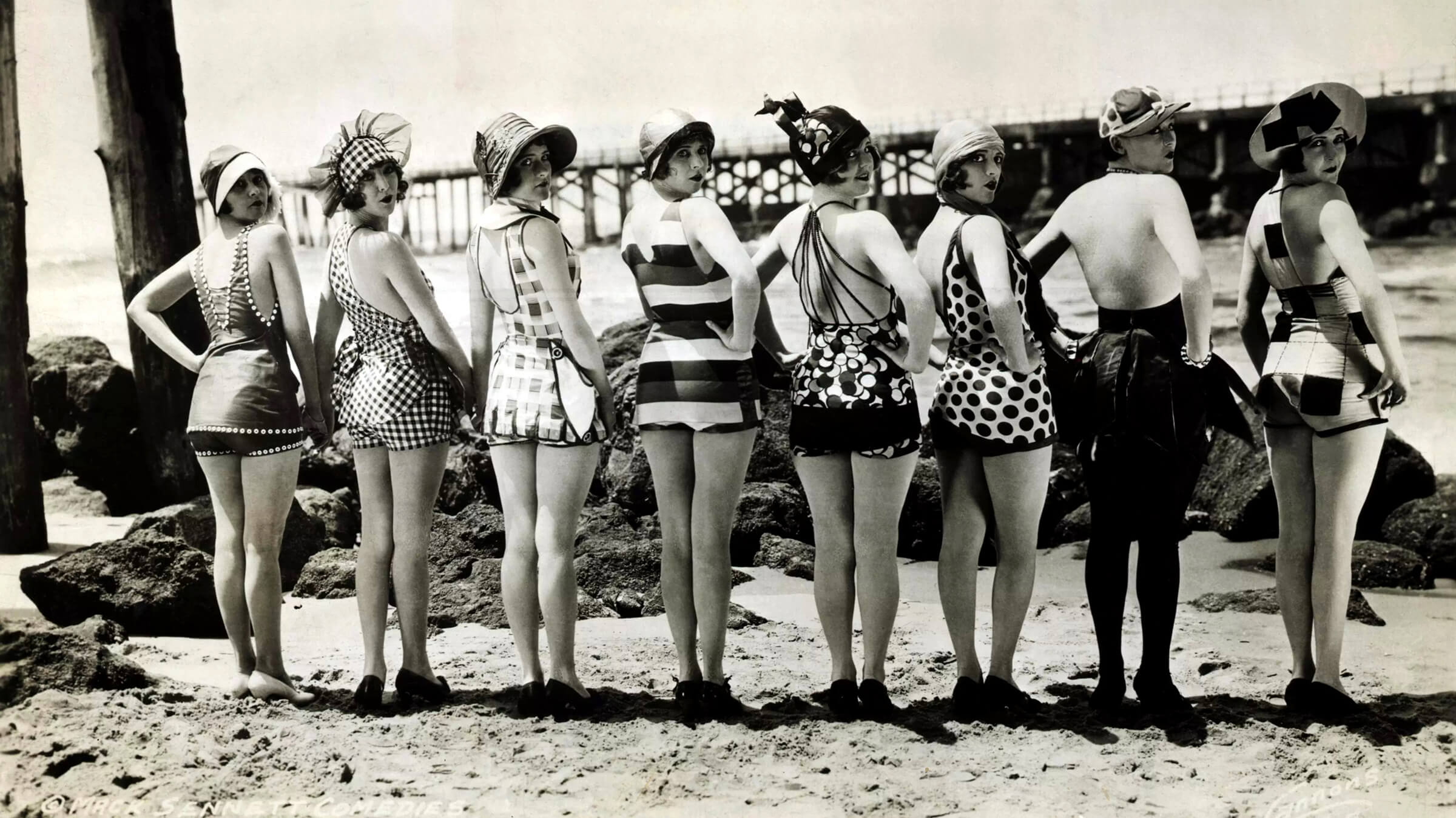Published in conjunction with the screening of Up in Mabel’s Room at SFSFF 2023
Playful, perky, and mischievous, these swim-ready gals were the pinup models of the World War I generation, sighed over by countless young men, no doubt some young women, and probably a few of their parents, too. As one wise guy in a 1918 issue of Film Fun proclaimed, “Mack Sennett has every male movieite in the U.S. raving over his Bunch of bathing beauties. No wonder the population of Los Angeles is increasing!” Exhibitors, noticing significant ticket sales for Keystone shorts that featured the Beauties, were more than happy to cash in. The girls were even immortalized in song via Ray Perkins’s “Help! Help! Mr. Sennett (I’m Drowning in a Sea of Love).” These actresses were not just eye candy, they were the whole candy aisle, since there was always a ton of them filling up the frame at once. Doing exercises, playing games, dancing, running, arguing—Sennett’s films used any ol’ excuse to show off those slender figures resplendent in striped, checked, or ruffled bathing suits, often accented by dark stockings or a slightly startling hat.
The Primordial
Mack Sennett and Mabel Normand had worked together at Biograph where she had starred in Sennett’s very first inkling of a “bathing girl” picture, Biograph’s The Diving Girl (1911), clad in a clingy black swimsuit. Normand was very athletic and happily showed off her diving skills again in one of the Keystone Film Company’s very first releases, The Water Nymph (1912). It wasn’t long before Sennett reasoned: why have just one pretty girl in a bathing suit when you can have a whole flock? So, he began deploying his newfound “Bathing Girls” to drum up audiences for his films, plastering their cheeky images in magazine spreads, newspaper ads, theater lobbies, postcards, and arcade cards. Not to mention parading them in actual Bathing Beauty competitions, like a September 1917 event in Venice Beach, where Sennett Beauties Mary Thurman, Juanita Hansen, Maude Wayne, and Marie Prevost walked off with the prizes.
The Exceptional
Sennett’s comedies often set aside chunks of running time to show a lively group of ten or more girls frolicking near the main characters, playing ballgames on a beach or poking fun at spooning couples (never mind how well these scenes serve the plot). Sometimes the Beauties showed up as run-of-the-mill “cabaret girls” or as something unique, such as “dancers engaged in Grecian outdoor dancing pursuits.” In one 1921 short, On a Summer’s Day, a few appeared as “farmerettes.” While many of its participants remained obscure, some became stars. Marie Prevost was an audience favorite in flapper farces until the end of the silent era, and her best pal Phyllis Haver was the original saucy Roxie Hart in 1927’s Chicago. Relative latecomer Carole Lombard parlayed appearances in eighteen Sennett films into a robust (if sadly too brief) career as screwball comedy’s sweetheart, beginning with 1934’s Twentieth Century.
The Costars
By the late 1910s the Bathing Beauties were fixtures on the movie screens, and other studios were taking notice. Copycats started springing up: Fox Sunshine Girls, Christie Studios Bathing Beauties, Hal Roach Bathing Girls—almost everyone wanted in on the act. And while it wasn’t often that Buster Keaton surrounded himself with them like he did for Hard Luck and years later in The Cameraman, he did seem to favor them for his “Girls,” using Sennett like a farm team for his many costarring love interests. Virginia Fox appeared in ten of his shorts, Sybil Seely was loaned out for five, Phyllis Haver costarred in one short, and Kathryn McGuire appeared in two of his features. Plus, both Marion Mack (The General) and Marceline Day (The Cameraman) may have done brief stints as Keystone Beauties. Why did Keaton use so many? A reflection years later by Virginia Fox, who went on to become Mrs. Darryl Zanuck, might be a clue: “If I was hanging from an elk’s head and they said, ‘Hold it,’ I held it—even if they went to lunch.”
The Bevy
Numerous Bathing Beauties fell in and out of the group from 1917 to the end of the 1920s, making a thorough list of all the names something of a conundrum. Besides the members already mentioned their ranks also included lesser known names like Ora Carew, Lois Boyd, Roxana McGowan, Vera Steadman, Isobel Keep, Cecille Evans, Ruth Hiatt, Mildred June, Eva Diltz, Edith Roberts, Myrtle Lind, June Day, Marion Aye, Harriet Hammond, Marvel Rea, Claire Anderson, Jane Allyn, Thelma Bates … and more. Some ladies remain unknown to this day, unless future intrepid researchers can shed light on their identities.
The Exception
Gloria Swanson always, somewhat vehemently, insisted that she was never a Bathing Beauty, even though the Internet is littered with photos of her in bathing gear during her days at Sennett’s studio. Yet in her first two Keystone films Gloria played “The Girl,” and by her third comedy she was starring alongside Bobby Vernon in 1916’s A Social Cub, the first in a series they did together. In general, the Bathing Beauties tended to be used as a team of anonymous pretty faces, a group which Gloria was never a part of on screen. The proliferating bathing suit images seem to be promos taken around the time of 1917’s The Pullman Bride. So congrats, Gloria, what you said seems to be true … from a certain point of view.
Adapted from the author’s 2015 post “Splashes of Fun” at Silent-ology.

